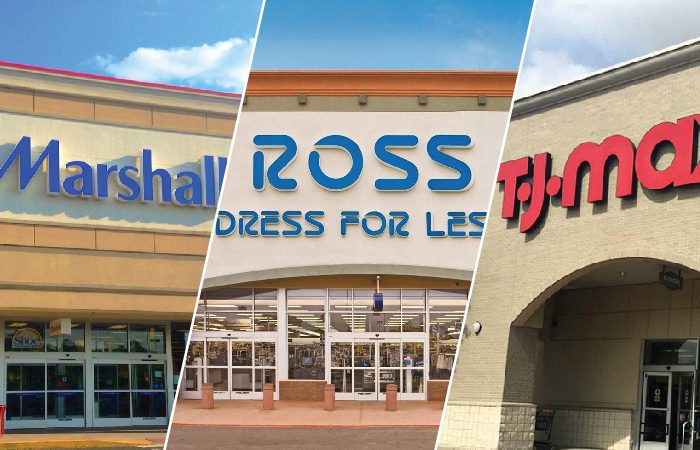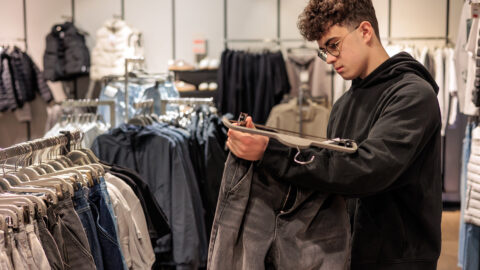The thrill of the in-store hunt is still going strong within the retail industry, as off-price retailers such as T.J. Maxx, Marshalls and Burlington Coat Factory continue to build momentum and outperform traditional department stores. In fact, according to a 2016 report from Moody’s Investors Service, off-price retailers are “anticipated to experience apparel revenue growth of 6% to 8%, outperforming the broader apparel segment by a collective 4% in the next five years.”
“TJX Companies, Ross Stores and Burlington continue to outpace overall apparel, which are growing at a much slower pace,” said Christina Boni, VP, Senior Analyst for Moody’s in a statement. “In contrast, the department store industry is losing share to off-price and other areas of apparel spending, as online competition increases and mall traffic continues to decelerate.”
So besides the excitement of finding an unexpected bargain, what draws shoppers to off-price stores? Experts point to a variety of factors:
- Consumers have become more value- and experience-oriented;
- Off-price offers a unique pricing structure that reveals the full price, the discounted price, and the amount of savings on tags; and
- Off-price stores are a one-stop-shop offering of apparel, home goods, beauty products and more.
Off-price retail success relies heavily on customers shopping in stores to hunt for treasures within the constantly-changing influx of inventory. Yet, industry experts agree that omnichannel must be top-of-mind and off-price retailers should start capitalizing on its potential.
While many off-price retailers are looking to keep a majority of their focus on physical stores, there is still a place for an online channel that complements the physical store experience.
“I don’t think anyone can avoid the omnichannel phenomenon,” said Paula Rosenblum, Co-founder and Managing Partner at RSR Research. “[Off-price retailers] may not put the entire assortment online and in stores, but a good portion of it must be synchronized. Omnichannel isn’t a ‘nice to have’ anymore. It’s table stakes. And treasure hunts are well and good, but they have to be synchronized.”
Creating An Omnichannel Strategy That Complements Physical Stores
T.J. Maxx reportedly isn’t terribly concerned with e-Commerce because of its reliance on the in-store treasure hunt experience; and the fact is T.J. Maxx e-Commerce sales “hover at just 1% of the business’ total sales,” according to Bloomberg News.
But even though the retailer doesn’t rely on e-Commerce sales, the brand still maintains an online presence. The retailer re-launched its e-Commerce web site following a hiatus, which now plays a complementary role to its physical stores.
“While [e-Commerce] is a small part of our business, we see it as highly complementary to our physical stores,” said Ernie Herrman, CEO of TJX CEO said in May as reported by Bloomberg. “We are being methodical in how we grow this business.”
T.J. Maxx’s take on “complementing” physical stores with some form of e-Commerce is something experts highlighted as necessary in creating a unified customer experience.
“I still think that the idea of finding personal treasures at the store is something [off-price retailers] need to capitalize on, and that can drive e-Commerce as well if executed in an online-friendly way,” said Mike Kim, Director at AArete, a global management consulting firm, in an interview with Retail TouchPoints.
Some ways off-price retailers can keep the fun of the in-store hunt alive include:
- Offering exclusive promotions from the e-Commerce platform to drive people to the stores;
- Having an easy to navigate store locator; and
- Developing unique content that inspires consumers, such as how to style items, tips on finding treasures in stores, etc.
Kim also asserted that an imaginative retailer could create an online version of a treasure hunt. “If off-price retailers are to expand their omnichannel strategy, it’ll be about improving and aligning inventory, figuring out how to price for physical and mobile offerings, and continuously engaging the customer, which is best done with data analysis to help map the customer journey.”
Of course, there are challenges to having a seamless online and offline off-price business. Aside from the inventory’s velocity, the need to align prices across channels and show the levels of inventory at brick-and-mortar stores in real time isn’t easy for any retailer, according to Kim.
“I would suggest a hybrid approach, where a consistent supply of certain items utilized by an e-Commerce approach, while also maintaining the personalized level of treasure hunting at the brick-and-mortar store for items that are highly fluid,” Kim said. “Focus on the distribution of brands that are high margin consistently over time and adapt that inventory to the omnichannel approach. That way, it minimizes disruption, given the speed at which items move.”
Off-Price Department Stores Flourish
Off-price retail as a segment has expanded significantly within the last several years, with almost every major department store introducing its own off-price brand, including Nordstrom Rack, Saks Off Fifth and Macy’s Backstage. As more traditional retailers introduce off-price brands, the off-price-only retailers are now faced with some heavy competition.
But according to Deborah Weinswig, Managing Director at Fung Global Retail & Technology, consumers are more drawn to off-price-only retailers. “Around half of U.S. consumers buy from off-price retailers; the proportion is slightly higher among the subgroup that also shops at Kohl’s and Macy’s,” she said. “Off-price specialist retailers such as T.J. Maxx continue to be shopped more heavily than off-price or discount divisions of department stores, such as Nordstrom Rack and Saks Off Fifth.”
Experts agree that while the models are very similar, both can coexist without feeling the heat. It essentially comes down to their customer demographics.
“Some of the success of off-price-only retailers so far is due to their conscious efforts to target a different customer demographic,” said Jared Wiesel, Partner at Revenue Analytics. “It’s rare to see the off-price-only retailers in the same areas as the name brand ones. Given they aren’t associated with a full price counterpart, they are not faced with concerns about customers shopping across full-price and off-price locations and potentially trading down. Thus, they are less constrained with the inventory they choose and how aggressive they want to be on price.”
It’s safe to say off-price retail isn’t going anywhere and has the potential to grow and expand into different markets. While omnichannel is still important, the physical store will stay at the forefront of off-price strategies to cater to the demands of their customers.
“We believe that the store will continue to be an integral part of the consumer experience,” said Michael Brown of the A.T. Kearney Consumer Products and Retail Practice. “The off-price sector will be a strong performer in retail going forward because of the opportunity that it offers customers to discover new products in an exciting and surprising way.”













